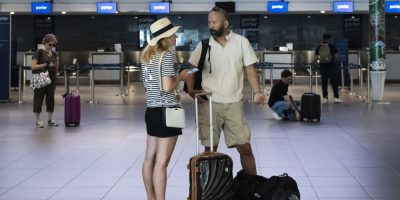
Russian forces Tuesday began storming the steel mill containing the last pocket of resistance in Mariupol, Ukrainian defenders said, just as scores of civilians evacuated from the bombed-out plant over the weekend reached safer territory and recounted days and nights filled with dread from constant shelling.
Osnat Lubrani, the U.N. humanitarian coordinator for Ukraine, said that thanks to the evacuation effort, “101 women, men, children and older persons could finally leave the bunkers below the Azovstal steelworks and see the daylight after two months.”
One evacuee said she went to sleep there every night afraid she wouldn’t wake up.
“You can’t imagine how scary it is when you sit in the shelter, in a wet and damp basement which is bouncing, shaking,” Yelena Tsybulchenko said upon arriving in the Ukrainian-controlled city of Zaporizhzhia, about 140 miles (230 kilometres) northwest of Mariupol, in a convoy of buses and ambulances.
She added: “We were praying to God that missiles fly over our shelter, because if it hit the shelter, all of us would be done.”
The news for those left behind was more grim. Ukrainian commanders said Russian forces backed by tanks began storming the sprawling plant, which includes a maze of tunnels and bunkers spread out over 11 square kilometres (4 square miles).
How many Ukrainian fighters were holed up inside was unclear, but the Russians put the number at about 2,000 in recent weeks, and 500 were reported to be wounded. A few hundred civilians also remained there, Ukrainian Deputy Prime Minister Iryna Vereshchuk said.
“We’ll do everything that’s possible to repel the assault, but we’re calling for urgent measures to evacuate the civilians that remain inside the plant and to bring them out safely,” Sviatoslav Palamar, deputy commander of Ukraine’s Azov Regiment, said on the messaging app Telegram.
He added that throughout the night, the plant was hit with naval artillery fire and airstrikes. Two civilian women were killed and 10 civilians wounded, he said.
The U.N.‘s Lubrani expressed hope for further evacuations but said none had been worked out.
In other battlefield developments, Russian troops shelled a chemical plant in the eastern city of Avdiivka, killing at least 10 people, Donetsk regional governor Pavlo Kyrylenko said.
“The Russians knew exactly where to aim — the workers just finished their shift and were waiting for a bus at a bus stop to take them home,” Kyrylenko wrote in a Telegram post. “Another cynical crime by Russians on our land.”
Explosions were also heard in Lviv, in western Ukraine, near the Polish border. The strikes damaged two power substations, knocking out electricity in parts of the city, the mayor said. Lviv has been a gateway for NATO-supplied weapons and a haven for those fleeing the fighting in the east.
Russian Defense Ministry spokesman Maj. Gen. Igor Konashenkov said Russian aircraft and artillery hit hundreds of targets in the past day, including troop strongholds, command posts, artillery positions, fuel and ammunition depots and radar equipment.
The assault on the Azovstal steelworks began almost two weeks after Russian President Vladimir Putin ordered his military not to storm the plant to finish off the defenders but to seal it off. The first — and so far only — civilians to be evacuated from the shattered plant got out during a brief cease-fire over the weekend, in an operation overseen by the U.N. and the Red Cross.
At a reception center in Zaporizhzhia, stretchers and wheelchairs were lined up, tiny children’s shoes dangled from a shopping cart and a pile of toys waited for the convoy. Medical and psychological teams were on standby.
The arrival of the convoy was a rare piece of good news in the nearly 10-week conflict that has killed thousands, forced millions to flee the country, laid waste to towns and cities, and shifted the post-Cold War balance of power in Eastern Europe.
“Over the past days, travelling with the evacuees, I have heard mothers, children and frail grandparents speak about the trauma of living day after day under unrelenting heavy shelling and the fear of death, and with extreme lack of water, food and sanitation,” Lubrani said. “They spoke of the hell they have experienced since this war started, seeking refuge in the Azovstal plant.”
Lubrani said many of the evacuees had run to the steel plant for safety and got trapped.
In addition to the 101 people evacuated from the steelworks, 58 joined the convoy in a town on the outskirts of Mariupol, Lubrani said. About 30 people who left the plant decided to stay behind to try to find out whether their loved ones were alive, Lubrani said. A total of 127 evacuees arrived in Zaporizhzhia, she said.
The Russian military said earlier that some of the evacuees chose to stay in areas held by pro-Moscow separatists.
About a dozen people taken out in the convoy were sick or injured, none of them critically, according to Pascal Hundt, head of the Ukraine office of the International Committee of the Red Cross.
Tsybulchenko rejected Russian allegations that the Ukrainian fighters wouldn’t allow civilians to leave the plant. She said the Ukrainian military told civilians that they were free to go but would be risking their lives if they did so.
“We understood clearly that under these murder weapons, we wouldn’t survive, we wouldn’t manage to go anywhere,” she said.
Mariupol has come to symbolize the human misery inflicted by the war. The Russians’ two-month siege of the strategic southern port has trapped civilians with little or no food, water, medicine or heat, as Moscow’s forces pounded the city into rubble. The plant in particular has transfixed the outside world.
After failing to take Kyiv in the early weeks of the war, Russia withdrew from around the capital and announced that its chief objective was the capture of Ukraine’s eastern industrial heartland, known as the Donbas.
Mariupol lies in the region, and its fall would deprive Ukraine of a vital port, allow Russia to establish a land corridor to the Crimean Peninsula, which it seized from Ukraine in 2014, and free up troops for fighting elsewhere in the Donbas.
But so far, Russia’s troops and their allied separatist forces appear to have made only minor gains in the eastern offensive, taking several small towns as they try to advance in relatively small groups against staunch Ukrainian resistance.
Ukraine’s resistance has been significantly bolstered by Western arms, and British Prime Minister Boris Johnson announced 300 million pounds ($375 million) in new military aid, including radar, drones and armoured vehicles.
In a speech delivered remotely to Ukraine’s parliament, he pronounced the battle Ukraine’s “finest hour,” echoing the words of Winston Churchill during World War II.
“Your children and grandchildren will say that Ukrainians taught the world that the brute force of an aggressor counts for nothing against the moral force of a people determined to be free,” Johnson said.
Associated Press journalists Inna Varenytsia and David Keyton in Kyiv, Jon Gambrell and Yuras Karmanau in Lviv, Mstyslav Chernov in Kharkiv, and AP staff around the world contributed to this report.
Feature image - The Associated Press via The Canadian Press






